Introduction
Since the introduction of Facebook 15 years ago, social media has made its way into most consumer’s everyday lives. Whether it’s to keep up on the latest trends or to share amusing videos, social media has permeated far past just American culture. As a modern business, it’s important to have a social media presence and to potentially implement social media advertising.
Organic vs Paid Social Media
When scrolling through social media, a feed features a variety of different types of posts. Those pictures, videos, etc. that show up without a sponsored tag are organic posts. They tend to be posted by friends, family, or companies that you follow without any financial investment involved.
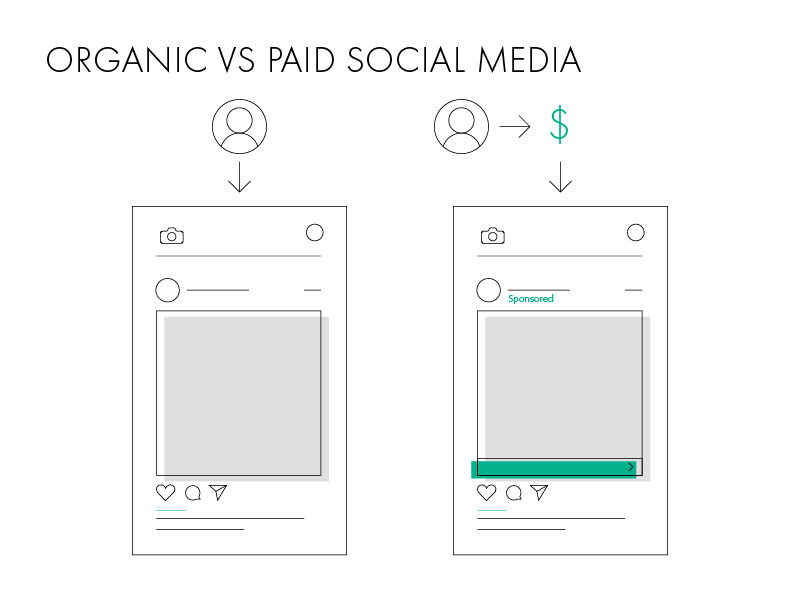
Nearly half of organic content, due to ever-changing algorithms, may never be shared. Without any investment, a post’s average marketing conversion rate is 1%. For grandma Esther that is not an issue, her goal on social media is not to drive engagement, all she wants is pictures of her grandchildren. But for a business, a 1% conversion rate with zero shares is not ideal.
Businesses can no longer rely on organic content to convert followers to customers. Paid posts are ads or boosted posts that are placed strategically in a social media feed. For businesses, paid social media advertising is the way to achieve a strong presence on platforms like Facebook, Instagram, and Twitter. These are becoming what are called “pay-to-play” platforms.
Why Advertise on Social Media?
Did you know, 42% of the world’s population is on social media? That’s 3.2 billion people. With that pool of people, it’s no wonder that social media has become a foundational channel for marketing to the public.
In the United States, daily use of social media spans generations. 90.4% of Millenials, 77.5% of Gen Xers, and 48.2% of Baby Boomers are on social media for an average of 2 hours daily. People live for and through social media. They spend more time looking at their phones than most other marketing channels.
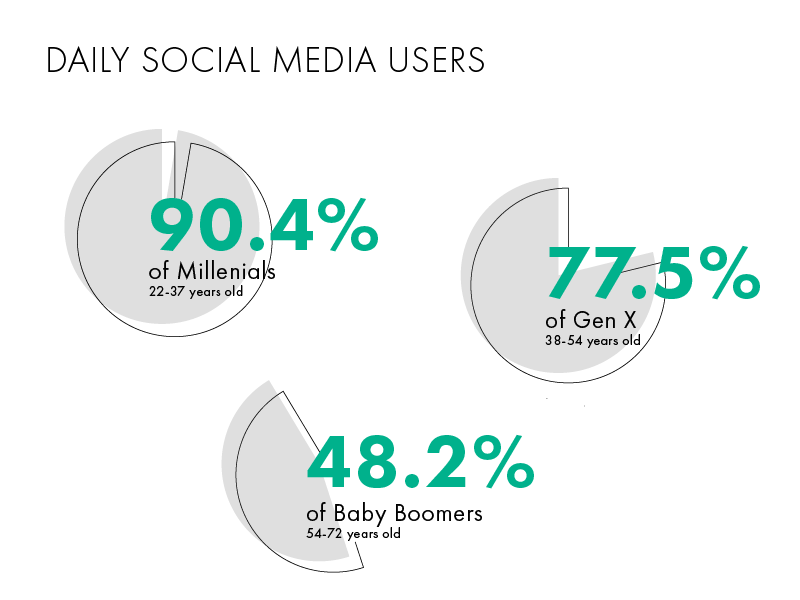
Through social media, businesses have a unique opportunity to target and engage their customers. Advertising personalization, testing, refinement, and success measurement are all easier through social media.
Social Media Advertising Benefits
Social media testing refines an ad campaign to maximize engagement. Due to the flexible nature of social media advertising, testing ads is a matter of trial and error which creates measurable results to act upon. A great way to test your ads is through A/B split testing. Split a sample of a specific target demographic and test two different ads on them using different copy or images. Which ever pulls more engagement you apply to the full target demographic. A/B testing is like a small test run that helps refine the ad. It gives you a trial comparison to optimize your ad space. Through the refinement of advertisements, potential customers become loyal customers.
More data on consumers is available now based on their activity on social media. Both the business and the consumer benefit from this collection of data. Social media ads target based on interests, online behavior, and life stages such as graduation, marriage, moving, etc. In turn, consumers are seeing ads aligned to where they are in life and their passions.
Establishing a brand identity on social media allows businesses to build rapport with their customers. Customers want to be heard and valued. Social media gives a company an accessible front for customers to interact with and show their loyalty or discontent. A well managed social media presence will create a positive association with your brand and boost customer loyalty.
Social Media Advertising Strategies
Setting a Goal
Similar to other advertising campaigns, a social media campaign involves a lot of planning. When in the initial stages, it is important to understand the goal of the campaign. A few examples of goals include things like increasing traffic, brand awareness, engagement, lead generation, and sales.
Choosing a Platform
After setting the goal of the campaign, decide on what platform or platforms to focus on. No social media platform is alike. Each platform has its own unique demographic that it appeals to. Choose the platform that aligns well with your business’s key demographic. Facebook has a broad range but individuals under 25 are not frequent users. Instagram and Twitter tend to appeal to 18-29-year-olds while Snapchat is mostly used by 18-24-year-olds.
Targeting
Understanding your target audience is key to honing in on the best target market. Finding a good target market involves taking the average of your broader audience and focusing in on them. Each social media channel has various targeting methods, but most include interest, behavior, and demographics (age, income, location, gender, etc).
Funneling
Understanding the funnel is the key to everything for Social Media Marketing. The goal is to deliver the right piece of content to the right person at the right time in order to mobilize them to the next phase of the relationship. If done right, it should be a perpetual system that is constantly finding new potential customers, and ascending them to loyal fans.
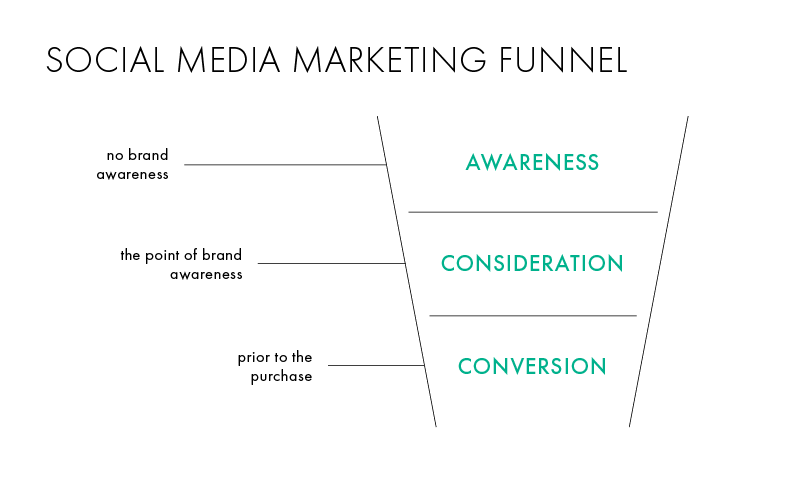
There are three stages that every customer goes through, awareness, consideration, and conversion. Awareness is the time right before your brand appears on a consumer’s radar. Consideration is where they are aware of your brand and could have even made a purchase in the past. Conversion is the tipping point. Once a consumer hits conversion, a single ad can lead them to purchase. By this point it is easy to over saturate the consumer with ads, try to avoid targeting this stage too heavily or they will get annoyed.
Testing
After your campaign has been running a specific period of time, compare ads that are reeling customers in and those who are not. Find the copy that is working within the ad. Let’s say one ad features a call to action saying “learn more” while another says “sign up”. If one is doing better than the other, consider using the effective copy in the struggling ad. Are certain images catching more eyes? Try using similar images in other ads. And finally, if an ad is not bringing satisfactory result make sure that the links are taking people where they need to go. A broken link will lead to frustration and not conversion.
Choosing the Right Platforms
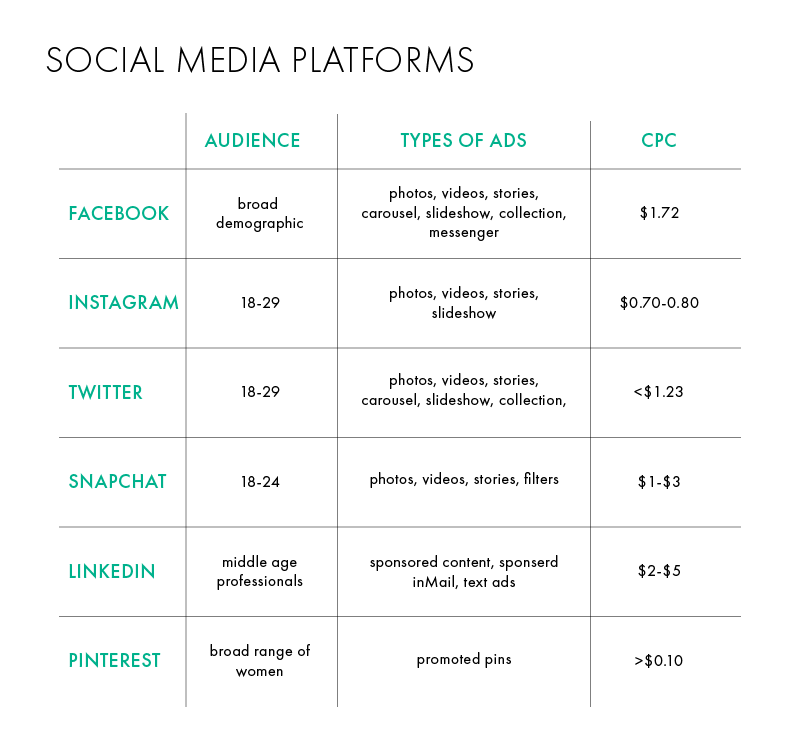
With 2 billion monthly users, Facebook is the hub of social media. It reaches the widest stretch of demographics and as a company, commands the other giants in the industry. Benefits of implementing Facebook ads include:
- Detailed Targeting
- Brand Awareness
- Increase in Web Traffic
- Email Lead generation
To best leverage your ad content, make sure you include a takeaway for your customer. This can be a giveaway, limited-time offer, or free shipping. Ads that feature similar content have a higher rate of clicks than those that do not.
Over 500 million people use this visually stimulating social media platform actively every month. In recent years it has experienced incredible growth and has captivated mostly younger generations. Using the ad feature on Instagram includes all of the benefits of using Facebook but with an increase in engagement. Instagram has a 48% higher engagement rate than Facebook and a 2000% higher engagement rate than Twitter. The type of companies that thrive on Instagram are those who have a visually appealing product due to the app’s visual nature.
Since Instagram values visuals, avoid using stock images in ad posts. Using stock photos makes it obvious to the consumer that they are looking at sponsored content rather than their usual feed. The goal of an Instagram ad should be to blend in with the feed so it looks organic yet stand out to your target audience.
To beat the algorithm and better target your audience, implement the use of hashtags. Unlike other platforms where hashtags are not useful, Instagram is built on hashtags. Utilize corresponding hashtags to your brand and content to stimulate engagement.
Although it is much lower than Instagram, Twitter’s engagement rate has raised by 151% last year. Since ads are well integrated into the feed, Twitter is excellent for brand awareness building. Twitter also touts that 41% of users will purchase a product after being exposed to an ad within the month. Due to the accurate “Who to Follow” section on Twitter, companies see an increase of interested followers through the promotion of their accounts on the platform. Hashtags are also very helpful when it comes to advertising on Twitter. Unlike on Instagram, hashtags on Twitter create threads of conversation on a topic. Famously, companies will have “Twitter Wars” with competitors or individuals, which can create a sharing frenzy. A well-executed Twitter strategy, with both paid and organic posts, boosts brand recognition while establishing loyal customers.
Snapchat
Snapchat appeals to younger social media users. Three-quarters of Gen Ys regularly use the app. With such a high concentration of Gen Ys using the app, companies who target the younger generation must have a presence on Snapchat. To grasp this audience’s attention, ads need to be entertaining and eye-catching. Headlines on story ads should beg to be pressed. By using language that excites, an ad’s click-through rate will skyrocket and user interaction will as well.
LinkedIn is a great platform to focus on working professionals. Targeting ads on LinkedIn can be as broad or specific as you’d like. From specific industries to the level of seniority, LinkedIn ads can attract a very niche group of individuals. When advertising on LinkedIn, it is best to use large images with headlines under 150 characters pointed to a call to action. Most users on LinkedIn want to read the headline and, in a short amount of time, gain an understanding of what is being offered. Attracting the eye with a large image and having a pithy headline and summary will increase the click-through rate.
To all of the DIYers of the world, Pinterest is their heaven. More than half of Pinterest users will purchase something from a company they see on the platform within a month. Pinterest users also spend 29% more than Non-Pinterest users, which can provide a great opportunity for companies selling products normally seen on the app. The app has mostly female users but not by a large margin and caters to a variety of ages. Ad content on Pinterest should be DIY by nature or offer inspiration. By encouraging the user to pin the ad, the ad will continue to live in that user’s board long after the campaign is over.
How Much Should You Spend?
Pricing on a social media ad campaign can be tricky. Spending a lot of money on social media does not guarantee a successful campaign. Establishing scope and accurately targeting your audience will help your campaign to succeed. There is, however, no one size fits all price when it comes to social media marketing. Your company and its customer base have unique needs when it comes to advertisements.
There are several factors that play into how much you should budget for social media advertising. Content creation is the first step to a social media campaign. Deciding whether or not you create content yourself or have a marketing team create it can affect your bottom line. There are website platforms like Canva that can make this process simple and budget-friendly. Hiring a content creator will make your content look refined but will come with a larger price tag. Understand that successful ads rely on both the content as well as the management of the content. There are a few options for social media ad management.
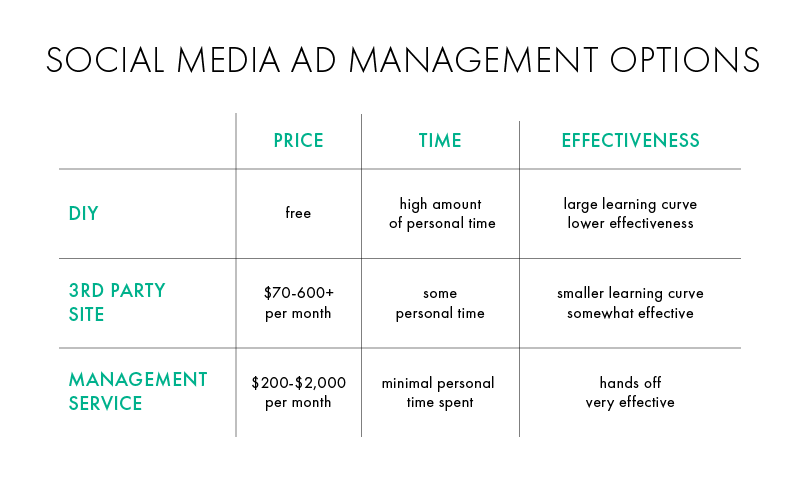
Smaller Budget
If you have a smaller business and do not have a budget to spend on a management service, DIY is a great option. There are plenty of resources online that can help you in targeting and purchase. However, a very large learning curve exists and you might find yourself spending more time managing your social media than running your business.
Larger Budget
If you have some budget to spend, a 3rd party management site can be a great time saver. Some 3rd party sites are very user-friendly, others are not. Make sure to shop around to ensure you chose one that fits your needs best. There will still be a learning curve when it comes to targeting and content, but these sites help with time spent when scheduling posts.
If you have a large enough budget, it is worth the costs to hire a digital advertising agency. Having professional help will take away the stress of managing social media and will ensure your targeting is pinpoint accurate.
Besides content and management, there are a variety of different factors that weigh in on how much a social campaign can cost:
- Location
- Quality of ad
- Campaign goal
- Frequency
- Target audience
- Time of year, the day, the time
- Placement
- Number of platforms
Roughly your price tag for a social media campaign can cost anywhere from a couple hundred dollars to thousands.
Social Advertising Tips & Tricks
Social media marketing can be tricky waters to maneuver. With practices and audience preferences changing every minute, it is important to stay on top of social media trends. Here are some tips and tricks on how to maneuver the world of social media.
Content Creation
A cohesive social media visual brand helps the customer to draw a connection to your paid and organic content on all platforms. When a consumer can identify visual elements across platforms, your ad will be more effective. Take inspiration for companies like Shake Shack and Starbucks. Their feeds on Instagram and Twitter are cohesive and call on the same visual aesthetic.
When creating a content marketing plan, it is important to understand the best dimensions for posts on both mobile and desktop. 91% of users view social media on mobile, so mobile should be your main focus while still keeping desktop in mind.
Your content on social media, both organic and paid, should provide value to the consumer. Your feed should have a variety of different types of value provided. A mix of entertaining, insightful, and discounted offerings will keep your followers attention.
Call to Action
For paid posts, your call to action is the final driving factor for engagement. Each platform has different options for a CTA. Most Instagram story CTAs involve swiping up while their shopping posts will solely be links featured on the image. When deciding what call to action to use, establish a clear action you want your customer to take. Do you want to increase website traffic? Have them swipe up to your landing page. Do you want to gain email leads? Have them sign up for a newsletter.
The wording on a call to action will affect the click-through rate. “Learn More” is the most common and effective phrase on Instagram, Facebook, and Twitter. On LinkedIn using “try”, “free”, “today”, “click” and “apply” in a call to action is most effective.
How to Measure Success?
The key to social media advertising is to measure and assess the results of your efforts. There are two types of measurements for social media, ongoing analytics and campaign centric metrics. Ongoing analytics look at social media activity over time. These metrics feel out tendencies and trends on the platform. Campaign focused metrics gain an understanding of the target market’s interactions with the ads. They reveal the success of the campaign reaching its goal.
When deciding on what metrics to use, always measure based on what your goals are. If you are wanting to increase brand awareness, look at new followers, volume, reach, and exposure. For boosted website traffic, look at the click-through rate and shares your URL is gaining. Increasing engagement can be measured by shares, comments, replies, and participants. Capture your metrics through either the provided tools on the platforms or through a 3rd party site.
After the metrics are gathered, analyze and create reports based on the data. Compare past and present data points, then assess the strengths and weaknesses of both. Depending on the scheduling of your posts, reporting can happen either monthly or quarterly. Use the reports, then, to fine-tune your social media strategy.
The Future of Social Media Advertising
Social media marketing has become a powerful marketing tool within the past few years. It has seen a rapid amount of growth and change since the introduction of Facebook and is sure to continue that growth. Some trends to stay on top of in the quickly changing world of social media include micro-influencers, stories for advertising, and a desire for authenticity.
In the past, businesses focused their budget on attracting huge celebrities for endorsements. More recently, that focus went into a few larger social media influencers. Now that there are so many influencers online, companies have downsized to micro-influencers. Micro-influencers are more approachable, smaller focused influencers.
More and more users are turning away from scrolling through their entire feed and are focusing more on their stories. This is a fantastic opportunity for marketers to create eye-catching, engaging content that will achieve their marketing goals. Specifically, marketers are predicting that IGTV is going to be the main channel of advertising on social media.
In 15 years that social media has been a part of our lives, as a viewer, we have become wary of deceit. The times where we trusted everything on the internet are long gone. Because of this users are seeking out authenticity on social media. Understanding what your brand’s value proposition is on social media and leveraging that authentically will lead to success in the long run.
Conclusion
Social media has positioned itself as a necessity in many people’s lives. They use it as entertainment, to increase knowledge, and to gain a sense of connectivity. Having a strong social media presence through advertising will position your company for successful conversion of potential customers to loyal customers.
Sources
https://blog.hootsuite.com/social-media-advertising/
https://sproutsocial.com/insights/topics/social-media-advertising/
https://www.wordstream.com/blog/ws/2016/06/30/social-media-advertising-tips
https://marketingl
https://www.bigcommerce.com/blog/social-media-advertising/
https://www.wordstream.com/blog/ws/2017/02/28/facebook-advertising-benchmarks
https://wallaroomedia.com/snapchat-advertising-costs/
https://neilpatel.com/blog/guide-to-linkedin-ads1/
https://influencermarketinghub.com/how-much-do-youtube-ads-cost/
https://www.upwork.com/hiring/marketing/cost-social-media-campaign/
https://strikesocial.com/blog/pinterest-advertising-cost/
https://blog.hootsuite.com/pinterest-ads/
https://later.com/blog/instagram-hashtags/
https://www.entrepreneur.com/article/223437

Recent Comments